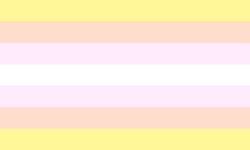Pangender: Difference between revisions
imported>TXJ |
imported>TXJ |
||
| Line 10: | Line 10: | ||
== History == | == History == | ||
Pangender is mentioned in the preface to ''The Flock'', a 1992 book by Lynn Wilson about dissociative identity disorder: "Some [[gender-nonconforming]] individuals call themselves [[androgyne]]s, pan-gender, or [[non-binary]]."<ref>{{cite book|title=The Flock|isbn=9780449907320|year=1992|last=Wilson|first=Lynn|page=xi|publisher=Fawcett Columbine}}</ref> | |||
Pangender was mentioned as one of many valid nonbinary identities in the 2013 text ''Sexuality and Gender for Mental Health Professionals: A Practical Guide''.<ref>{{cite book|isbn=9781446293133|title=Sexuality and Gender for Mental Health Professionals: A Practical Guide|last1=Richards|first1=Christina|last2=Barker|first2=Meg|year=2013|publisher=SAGE Publications}}</ref> | Pangender was mentioned as one of many valid nonbinary identities in the 2013 text ''Sexuality and Gender for Mental Health Professionals: A Practical Guide''.<ref>{{cite book|isbn=9781446293133|title=Sexuality and Gender for Mental Health Professionals: A Practical Guide|last1=Richards|first1=Christina|last2=Barker|first2=Meg|year=2013|publisher=SAGE Publications}}</ref> | ||
Revision as of 16:50, 19 June 2020
 Meaning -Yellow: gender without reference to the binary. Light red: transition to genders related to female and male. Light violet/pink: combination of female and male. -White: blend of all these genders. The colors are very light because white is the combination of all colours. | |
| Related identities | multigender, polygender |
|---|---|
| Click here to see alternative flags! | |
Pangender, or omnigender, is a gender identity that encompasses a large number of or all genders (of one's culture, because one cannot identify with gender(s) outside their culture). This could mean feeling many or all genders at the same time or being fluid between many or all genders across time. Thus a pangender person can also be genderfluid or genderflux. The combination of pangender and genderflux is called panflux. A pangender person who identifies with all genders can include genders not currently recognized or known[1]. Pangender people can use any set of pronouns they choose or vary between pronouns depending on how they identify at the time.
History
Pangender is mentioned in the preface to The Flock, a 1992 book by Lynn Wilson about dissociative identity disorder: "Some gender-nonconforming individuals call themselves androgynes, pan-gender, or non-binary."[2]
Pangender was mentioned as one of many valid nonbinary identities in the 2013 text Sexuality and Gender for Mental Health Professionals: A Practical Guide.[3]
In 2018, Washington state began to allow "X" gender markers on official documents[4], with the law stating that
| « | "X" means a gender that is not exclusively male or female, including, but not limited to, intersex, agender, amalgagender, androgynous, bigender, demigender, female-to-male, genderfluid, genderqueer, male-to-female, neutrois, nonbinary, pangender, third sex, transgender, transsexual, Two Spirit, and unspecified.[5] | » |
Please help expand this section.
Notable pangender people
See main article: Notable nonbinary people
There are many more notable people who have a gender identity outside of the binary. The following are only some of those notable people who specifically use the words "pangender" or "omnigender" for themselves.
Please help expand this section.
Pangender characters in fiction
See main article: Nonbinary gender in fiction
There are many more nonbinary characters in fiction who have a gender identity outside of the binary. The following are only some of those characters who are specifically called by the words "pangender" or "omnigender," either in their canon, or by their creators.
Please help expand this section.
See also
References
- ↑ http://gender.wikia.com/wiki/Pangender
- ↑ Wilson, Lynn (1992). The Flock. Fawcett Columbine. p. xi. ISBN 9780449907320.
- ↑ Richards, Christina; Barker, Meg (2013). Sexuality and Gender for Mental Health Professionals: A Practical Guide. SAGE Publications. ISBN 9781446293133.
- ↑ Jackman, Josh (5 January 2018). "Washington to recognise third gender in groundbreaking move". PinkNews. Retrieved 14 May 2020.
- ↑ "WAC 246-490-075: Changing sex designation on a birth certificate". Washington State Legislature. Retrieved 14 May 2020.
